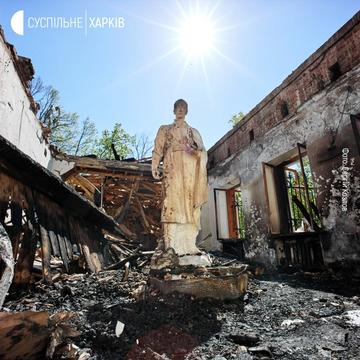June 2022 Blog: The indestructible Ukrainian culture
On 12 June, while discussing Ukraine’s prospects for future membership in the bloc, the EU’s High Representative/Vice President, Josep Borrell, said he was convinced that Ukraine was (part of) the European culture. A day earlier, President Biden gave another of his assessments of Russia’s war against Ukraine, stating that one of Putin’s goals was to obliterate the Ukrainian culture. While initially, in the context of Russia’s invasion, the Ukrainian culture was not given much attention, at least by international observers, at this stage of the war it is becoming more obvious that the destruction of museums, schools and libraries is part of Russia’s wider strategy to destroy Ukraine as an independent state.
The Ministry of Culture and Information Politics of Ukraine created a web platform for recording Russian crimes against Ukraine’s cultural heritage since the start of the invasion on 24 February 2022. Anyone can submit evidence of the crimes, irrespective of how big or small they might seem. The idea of this is to create an evidence base to underpin the criminal prosecution of those involved, under Ukrainian law and in a special tribunal after its establishment. At the time of writing, nearly 400 entries have been made, documenting different levels of destruction and damage. It records that 9 heritage sites were completely destroyed, while 58 were severely damaged and a further 123 suffered “moderate damage”. With 20 per cent of the Ukrainian territorycurrently under occupation, the state of many cultural heritage sites is unknown and is unlikely to be discovered until the liberation.

The list, compiled by the Ukrainians, is striking not only due to the sheer number of entries (all while Russia continues insisting that it targets exclusively military targets), but also due to their variety. Some of the heritage sites are highly prominent, like the National Literary and Memorial Museum of Hyrhorii Skovoroda that was struck by a Russian missile on 6 May. Skovoroda, who was a poet and philosopher, lived, worked and was buried in the grounds of the now destroyed museum building in a small village near Kharkiv - named after him - Skovorodynivka. The museum was remote from any objects of military or strategic infrastructure. The strike was deliberate and was labelled by CNN as an act of cultural vandalism. And even though most of Skovoroda’s works and artefacts had been removed from the museum, the destruction of the building is still considered a big loss as noted by President Zelensky. Hryhoriy Skovoroda himself, however, would not necessarily see it as such, after all - his most valued possession was his freedom. When he was invited by Catherine the Great to join her court in St Peterburg, he famously replied: “To me, my reed pipe and sheep are more valuable than a royal crown”.
Other targets of Russian aggression could be considered less significant, such as the recently renovated Palace of Culture, in another part of Kharkiv region, the city of Lozova. While the building housed no significant artefacts, it is still notable for what it represents – the Ukrainian culture. No cultural site in Ukraine, therefore, should be seen as too small or insignificant in this war, as they are all targeted for what they stand for, i.e. an independent and free Ukraine, which the Kremlin wants to destroy. That is why it does not go unnoticed when Russians change the Ukrainian inscription on markers at the entrance to occupied cities and towns into Russian, even if the change involves just one letter (as in the case of Mariupol) or paint over murals with Ukrainian symbols or Ukrainian words (as with a poem by one of Ukraine’s most loved contemporary poets - Serhiy Zhadan - in his native town of Starobilsk, in Luhansk region).
But no matter what damage Russia causes, the Ukrainian culture will survive, like it did for centuries when Putin’s predecessors tried to destroy it before. It survived when Peter the Great prohibited the publication of books in Ukrainian in 1720. It survived the ban of the Ukrainian language by the Valuev Circular and the Ems Decree in the late 19th century, the murder and repressions of the brightest poets, writers and artists of the nation in the 1920s-1930s (what is now known as the Executed Renaissance) and the Russification of Ukrainian schools in 1959. These are examples from history, but there are plenty more from the current war. The resilience of the Ukrainian culture is “heard” when Andriy Khlyvniuk, a lead singer of Boombox, one of Ukraine’s most popular bands, sings a patriotic march Oi u luzi Chervona Kalyna/Red Viburnum in the Meadow in the empty St Sofia’s Square in the centre of Kyiv a few days after the invasion, and when a special rendition of that song is then recorded by the legendary rock band Pink Floyd (which re-formed to record a new song for the first time in 28 years). The resilience of the Ukrainian culture is “seen” when a painting by Maria Prymachenko, an artist, whose works were admired by Pablo Picasso and whose museum was destroyed by a Russian rocket in March 2022, under a symbolic title “Flowers near the fourth (Chernobyl’s) reactor” was auctioned for half a million US dollars to support the Ukrainian Armed Forces. The Ukrainian culture is felt, when the Ukrainian poet, writer and musician Serhiy Zhadan, who was nominated for this year’s Nobel Prize in Literature, gives daily updates about his volunteer work under constant shelling in Kharkiv, Ukraine’s second largest city, and when Andrei Kurkov, a Ukrainian author, tirelessly tours the world to speak about Ukraine in nearly a dozen languages that he has mastered.
A country with a culture like this cannot be defeated. Ukraine will not just survive, it will become stronger, and its culture will grow even more vibrant, recognised and understood around the world.
Dr Anastasiia Kudlenko
Research Fellow, the University of Warwick
